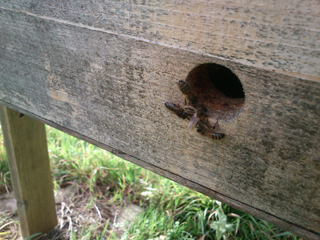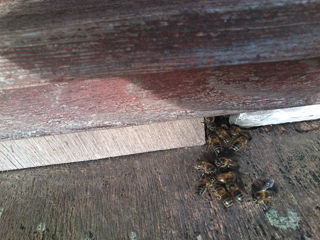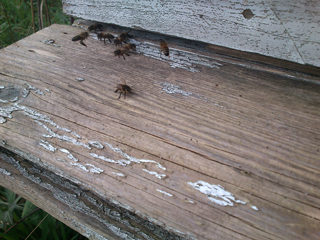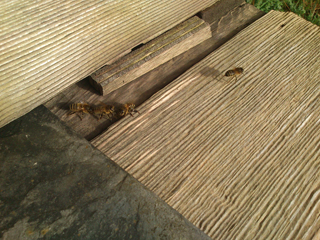 There’s not a lot to report this month, as December is perhaps the quietest month in the beekeeping calendar. There are few flowers or plants in bloom, let alone any yielding nectar, which, coupled with the “normal” weather experienced in December, means there is usually no incentive for the bees to fly from their hive, other than to void their faeces. However, as you will see from the pictures this month, the warm weather has been tempting them to come out of their front doors to have a look.
There’s not a lot to report this month, as December is perhaps the quietest month in the beekeeping calendar. There are few flowers or plants in bloom, let alone any yielding nectar, which, coupled with the “normal” weather experienced in December, means there is usually no incentive for the bees to fly from their hive, other than to void their faeces. However, as you will see from the pictures this month, the warm weather has been tempting them to come out of their front doors to have a look.
When I went round my hives at home on Christmas Eve, they were all showing signs of activity – some more than others! The poor bees! They must be totally confused when the shortest days of the year offer temperatures more reminiscent of a Spring day – it’s no wonder they’re hanging around their entrances wondering whether they’ve read the signs correctly or not!
B ut I have no choice but to leave them well alone. The bees should be in cluster, conserving their stores and their energy so that both will last through the winter months (whenever they might arrive), but because of the warm weather they will be eating their stores to fund their activity and to feed the young larvae which have hatched (undoubtedly) from the eggs the queen is likely to have been laying.
ut I have no choice but to leave them well alone. The bees should be in cluster, conserving their stores and their energy so that both will last through the winter months (whenever they might arrive), but because of the warm weather they will be eating their stores to fund their activity and to feed the young larvae which have hatched (undoubtedly) from the eggs the queen is likely to have been laying.
Normally, in the winter months, the queen virtually stops laying, so that the bees don’t have to expend such energy in processing stores to feed these hatched larvae, but in conditions such as we are currently experiencing, the queen will be laying at a much greater rate than is normal, so the bees are still fairly active. If I open the hive to check what’s going on, I will be disturbing the equilibrium of the hive and will risk making it and the larvae cold. The bees will then need to expend even more energy to get things back to normal once I’ve finished, which is extremely stressful to them at this time of year – and uses up ever more stores! Even if I found a problem that could be resolved were it to arise in the beekeeping season, there is nothing I could do about it at this time of year, so neither the bees nor I would derive any benefit from an examination. I therefore leave well enough alone.
 Having said that, there are some beekeepers who will use this winter period of low brood numbers to apply a Varroa treatment to their bees. I am not one of those beekeepers! The reason for this is that the method of application is to open the hive (remember, we’re talking about doing this in the depths of winter, when it’s really cold and there are virtually no larvae in the brood nest!) and then to trickle a solution of oxalic acid in sugar syrup over the seams of bees (those bees that are clustered on the faces of the frames, which look like padding in between the combs when viewed from above).
Having said that, there are some beekeepers who will use this winter period of low brood numbers to apply a Varroa treatment to their bees. I am not one of those beekeepers! The reason for this is that the method of application is to open the hive (remember, we’re talking about doing this in the depths of winter, when it’s really cold and there are virtually no larvae in the brood nest!) and then to trickle a solution of oxalic acid in sugar syrup over the seams of bees (those bees that are clustered on the faces of the frames, which look like padding in between the combs when viewed from above).
The oxalic acid kills the phoretic Varroa mites (those mites that are on the external body parts of the bees, as opposed to those hiding in the brood cells under developing larvae), which is why ApiBioxal (the only approved form of oxalic acid for this treatment) should only be applied in the depths of winter as there is (supposed to be) no brood, meaning that all the Varroa mites are accessible on the bodies of the bees. My personal view is that this is too disruptive for the bees, though I have to say a lot of beekeepers swear by it as an effective treatment.
 I guess that’s one of the things that differentiates “natural beekeepers” from the others, in that I will not do anything “unnatural” to my bees. After all, they’ve managed for millions of years without our involvement and have developed strategies to deal with the problems they’ve encountered during this time. I have been using icing sugar dusting to “treat” my bees for Varroa for several years now, on the basis that icing sugar is not a chemical, it can be used by the bees as a food and it encourages them to develop grooming techniques which dislodge the Varroa mites from the bodies of the other bees, as well as from their own bodies.
I guess that’s one of the things that differentiates “natural beekeepers” from the others, in that I will not do anything “unnatural” to my bees. After all, they’ve managed for millions of years without our involvement and have developed strategies to deal with the problems they’ve encountered during this time. I have been using icing sugar dusting to “treat” my bees for Varroa for several years now, on the basis that icing sugar is not a chemical, it can be used by the bees as a food and it encourages them to develop grooming techniques which dislodge the Varroa mites from the bodies of the other bees, as well as from their own bodies.
Once a Varroa mite is dislodged and falls off the bee, it will die away from its host, as it no longer has a source of food (the bee’s blood). This is also why artificial swarms are so important (I’ll talk about these later in the year) as they induce a period of broodlessness in the colony, during time which the Varroa mites cannot reproduce and during which they can be dislodged by icing sugar dusting whilst there is no brood for the developing Varroa to hide under. What is called a “win-win” situation!
 Finally, I will shortly be preparing some sugar candy patties for the bees as a supplement to their ivy stores which they gathered during September and October. The ivy flow this year (end of 2016) was not particularly long or good, so without looking inside the hives my guess would be that the bees would benefit from such a “back-up” being made available to them. If they don’t need it, they won’t use it. But more about this next month.
Finally, I will shortly be preparing some sugar candy patties for the bees as a supplement to their ivy stores which they gathered during September and October. The ivy flow this year (end of 2016) was not particularly long or good, so without looking inside the hives my guess would be that the bees would benefit from such a “back-up” being made available to them. If they don’t need it, they won’t use it. But more about this next month.
In the meantime, a Happy and Healthy New Year to you all and I look forward to seeing what 2017 brings in terms of change and improvement, both with our honey bees and mankind in general.
Colin Rees – 01872 501313 – colinbeeman@aol.com

What an interesting article… thank you for enlightening me on ‘bee keeping’. I will look forward to reading more.